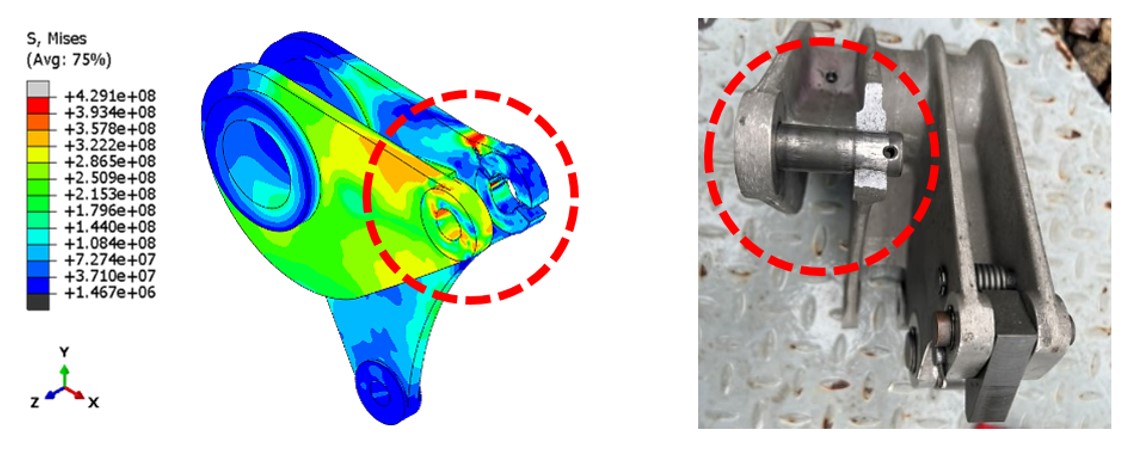Design and Analysis of Shear Pin of Lever Arm in Generator Circuit Breaker Using Finite Element Method
Main Article Content
Abstract
Interruption in mechanism of the generator circuit breaker is a main cause of an overload impact and fracture of lever arm, resulting in suspension of the power plant’s electricity transmission. Recently, shear pin has gained more interest owing to its ability to be a force-transmitting and break-away parts. Herein, finite element simulation analysis was investigated using Abaqus explicit software. Three-dimensional (3D) model of the lever arm and clevis pin were simulated based on actual dimension and velocity for analysing stress and force between the lever arm and pin due to impact. Notch and hollow pins with different shear cross-sectional areas were also simulated using the similar model. Deformation, energy dissipation, and failure load of various shear pin dimensions were investigated to yield the suitable shear pin for preventing lever arm’s fracture. The great potential notch pin with 6 mm in-depth to protect the lever arm from damages could be assumed.
Article Details

This work is licensed under a Creative Commons Attribution-NonCommercial-ShareAlike 4.0 International License.
This work is licensed under a Creative Commons Attribution-NonCommercial-ShareAlike 4.0 International License.
References
Dufournet D. AC high-voltage circuit breakers. Maine: IEEE; 2017.
Alstom Company. Instruction manual of SF6 circuit breaker XFT15-FXT16 with spring operation mechanisms FK3-4. Paris: Alstom Company; 2000.
GE Grid. Backgrounder of technical improvement to FK3-4/127 and FK3-5/127 spring operating mechanisms. Oberentfelden: GE Grid; 2016.
Boonsong C, Nithinuna K. The root cause failure analysis (RCFA) of broken lever problems of 230 kV circuit breaker for power generation. Nonthaburi: Electricity Generating Authority of Thailand; 2012. (In Thai)
Kiran Kumar BS, Venkata Rama Reddy M, Kumar K. Pin shear –material testing and validation using finite element analysis (ANSYS). Int J Eng Res Technol. 2015;4(7):165-170.
Budiman BA, Suharto D, Djodikusumo I, Aziz M, Juangsa FB. Fail-safe design and analysis for the guide vane of a hydro turbine. Adv Mech Eng. 2016;8(7):1-8.
Sankar S, Nataraj M, Prabhu Raja V. Failure analysis of shear pins in wind turbine generator. Eng Fail Anal. 2011;18(1):325-339.
Yu M, Zhang P, Xue C. Diameter-thickness ratio influence on large civil aircraft fuse pins’ strength. J Phys Conf Ser. 2022;2368:012029.
Hiremath S, Chiniwar DS, Singh Z, Behera A, Saxena KK, Vishwanatha HM. Modelling and simulation of lightweight hollow pins as a substitution for solid shear pins used for assembly joints in aerospace applications. Int J Interact Des Manuf. 2023;17:2593-2606.
Zhang P, Nie H, Wu J, Yu M. Emergency separation simulation and damage Prediction of an airliner under wheel-up landing condition. Shock Vib. 2021;2021:1-19.
Jin Z, Zhou J, Li D. Finite element simulations of dynamic shear fracture of shear pins. Int J Aerosp Eng. 2021;2021:1-16.
Kaufman JG, Rooy EL. Aluminum alloy castings: properties, processes, and applications. USA: ASM International; 2004.
Brnic J, Turkalj G, Canadija M, Lanc D, Krscanski S. Martensitic stainless steel AISI 420 mechanical properties, creep and fracture toughness. Mech Time-Depend Mater. 2011;15:341-352.
Gupta S, Abotula S, Shukla A. Determination of Johnson-Cook parameters for cast aluminum alloys. J Eng Mater Technol. 2014;136(3):034502.
Korkmaz ME, Günay M. Finite element modelling of cutting forces and power consumption in turning of AISI 420 martensitic stainless steel. Arab J Sci Eng. 2018;43:4863-4870.
Zwilsky KM, Langer EL. Properties and selection: nonferrous alloys and special-purpose materials. USA: ASM International; 1990.
Ulas HB, Ozkan MT. Turning processes investigation of materials austenitic, martensitic and duplex stainless steels and prediction of cutting forces using artificial neural network (ANN) techniques. Indian J Eng Mater Sci. 2019;26:93-104.
Mae H, Teng X, Bai Y, Wierzbicki T. Comparison of ductile fracture properties of aluminum castings: sand mold vs. metal mold. Int J Solids Struct. 2008;45(5):1430-1444.
Mahdavian SM, Mai YW, Cotterel B. Friction, metallic transfer and debris analysis of sliding surfaces. Wear 1982;82(2):221-232.
Budynas RG, Nisbett JK. Shigley’s Mechanical Engineering Design. 10th ed. New York: McGraw-Hill Education; 2015.



